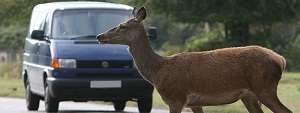When Do Most Deer Collisions Occur in UK?
In fact, you can find deer roaming about at any time of the year in Britain. But, they tend to be most active in the Spring and during the Autumn months.
As a result, the risk for motorists being involved in a deer collision increases and peaks at certain times of the year.
Drivers will most likely see deer leaping out of hedges for a few hours before and after sunrise and then again from dusk to midnight.
This is when hoofed ruminants (e.g. fallow deer, red deer, muntjac) and other wild animals are crossing country roads searching for new territories.
Statistics suggest there are around 1.5 million deer living wild in Great Britain. So, it is important for motorists to be aware of their presence, particularly when the animals are on the move.
The installation of deer warning signs focuses in areas with high numbers. The purpose is to alert drivers to the higher possibility of encountering deer herds along a given stretch of road.
Furthermore, Highways England announced some ‘deer aware’ safety advice and tips for all motorists, especially those who travel along country lanes.
Some of the typical and dangerous deer activities that drivers should expect and anticipate, include:
- After spotting and avoiding one you should expect others to follow and without warning.
- Some species of deer (e.g. muntjac) often gather in large groups (herds).
- Watch out for deer hidden in nearby foliage or woodlands which may dart out into the roadway.
Note: The deer sign is one of the Highway Code animals signs placed at selected locations. These warning signs inform drivers to slow down and allow more time to react.
The Deer Initiative Advice for Drivers
- Motorists should use full-beams after darkness – providing there is no opposing traffic. The beam of the headlight will illuminate the eyes of any deer present on or close to a roadway.
 Then, dim the headlights after seeing deer in the road. The beam is likely to startle the animal, which causes them to ‘freeze’ – rather than leave the roadway.
Then, dim the headlights after seeing deer in the road. The beam is likely to startle the animal, which causes them to ‘freeze’ – rather than leave the roadway.
Data and figures collated from studies on deer collisions, suggest well over 70,000 of these wild ruminants are killed by vehicles across the country every year. Injuries to motorists and passengers from this type of impact could well be close to 1,000 on an annual basis.
Conservative figures suggest there are at least twenty (20) fatalities a year caused by road crashes with roaming deer.
If You Hit a Deer while Driving
As a motorist, you should never over-swerve to avoid hitting a deer on the road. But, after hitting one, your priorities would be to:
- Keep yourself as safe as possible (and anyone else with you).
- Park the vehicle in the safest place and switch on the hazard warning lights.
- Consider using your car to warn other road users of the incident.
- Call for an ambulance if there are any human injuries and then call the police.
If the Deer is Alive and Visible
- Approaching an injured deer may cause it to run around other traffic. So it is best not to approach it to avoid causing another road accident.
- As a rule, it is best not to try and move or handle live deer. They are likely to struggle which may result in an injury (for you and the animal).
- Sitting with the animal, or trying to keep it warm (e.g. with a blanket), is unlikely to benefit an injured deer.
- Always contact the police if you are involved in a deer vehicle collision and require assistance.
Note: You can get more safety advice or report a deer vehicle collision through the Deer Aware website.

